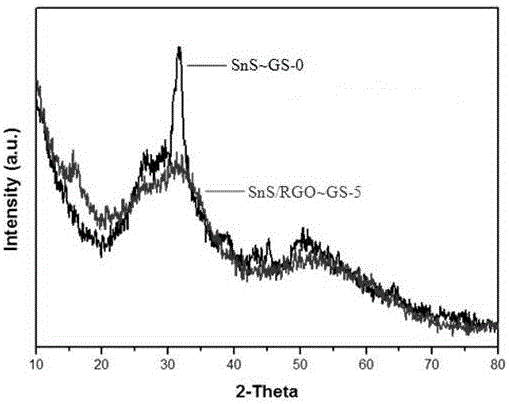Preparation method for stannous sulfide/graphene compound photocatalyst
A graphene composite and photocatalyst technology, applied in chemical instruments and methods, light water/sewage treatment, water/sludge/sewage treatment, etc., can solve the problem of weak redox ability, ineffective degradation of pollutants, band gap Narrow width and other issues, to achieve the effect of wide absorption spectrum range, strong market application value, and stable performance
- Summary
- Abstract
- Description
- Claims
- Application Information
AI Technical Summary
Problems solved by technology
Method used
Image
Examples
Embodiment 1
[0010] 1.127g SnCl 2 2H 2 O was dissolved in 50mL of ethylene glycol, and then 0.381g of thiourea was added to the above solution under the condition of magnetic stirring. After continuing to stir for 2h, the mixture was transferred to a polytetrafluoroethylene reactor, and hydrothermally reacted at 160°C for 6h. After the reaction was completed, it was naturally cooled to room temperature, separated by filtration, washed three times with water and ethanol, and then dried in a constant temperature drying oven at 60°C to obtain a stannous sulfide visible light catalyst, marked as GS-0. After 3h 500w Xe lamp visible light irradiation, the decolorization rate of stannous sulfide to RhB was 39.2%.
Embodiment 2
[0012] Add 0.008g of graphene oxide into 50mL of ethylene glycol, sonicate until completely dispersed, then magnetically stir for 2h, and 1.127g of SnCl 2 2H 2 O was added to the above solution, and then 0.381g of thiourea was added to the above solution under the condition of magnetic stirring, and the magnetic stirring was continued for 2 hours, then the mixed solution was transferred to a polytetrafluoroethylene reactor, and hydrothermally reacted at 160°C for 6 hours , naturally cooled to room temperature after the reaction was completed, separated by filtration, washed three times with water and ethanol, and then dried to obtain a stannous sulfide / graphene composite photocatalyst with a mass ratio of graphene and stannous sulfide of 1:100, marked as GS- 1. After 3h 500w Xe lamp visible light irradiation, the decolorization rate of RhB by the stannous sulfide / graphene composite photocatalyst was 42.8%.
Embodiment 3
[0014] Add 0.038g of graphene oxide into 50mL of ethylene glycol, sonicate until it is completely dispersed, then magnetically stir for 2h, and 1.127g of SnCl 2 2H 2 O was added to the above solution, and then 0.381g of thiourea was added to the above solution under the condition of magnetic stirring, and after continuing magnetic stirring for 2h, the mixed solution was transferred to a polytetrafluoroethylene reactor, and reacted hydrothermally at 160°C for 6h, After the reaction was completed, it was naturally cooled to room temperature, separated by filtration, washed three times with water and ethanol, and then dried to obtain a stannous sulfide / graphene composite photocatalyst with a mass ratio of graphene and stannous sulfide of 1:20, marked as GS-2 . After 3h 500w Xe lamp visible light irradiation, the decolorization rate of RhB by the stannous sulfide / graphene composite photocatalyst was 50.7%.
PUM
| Property | Measurement | Unit |
|---|---|---|
| decolorization rate | aaaaa | aaaaa |
| decolorization rate | aaaaa | aaaaa |
| decolorization rate | aaaaa | aaaaa |
Abstract
Description
Claims
Application Information
 Login to View More
Login to View More - R&D
- Intellectual Property
- Life Sciences
- Materials
- Tech Scout
- Unparalleled Data Quality
- Higher Quality Content
- 60% Fewer Hallucinations
Browse by: Latest US Patents, China's latest patents, Technical Efficacy Thesaurus, Application Domain, Technology Topic, Popular Technical Reports.
© 2025 PatSnap. All rights reserved.Legal|Privacy policy|Modern Slavery Act Transparency Statement|Sitemap|About US| Contact US: help@patsnap.com

